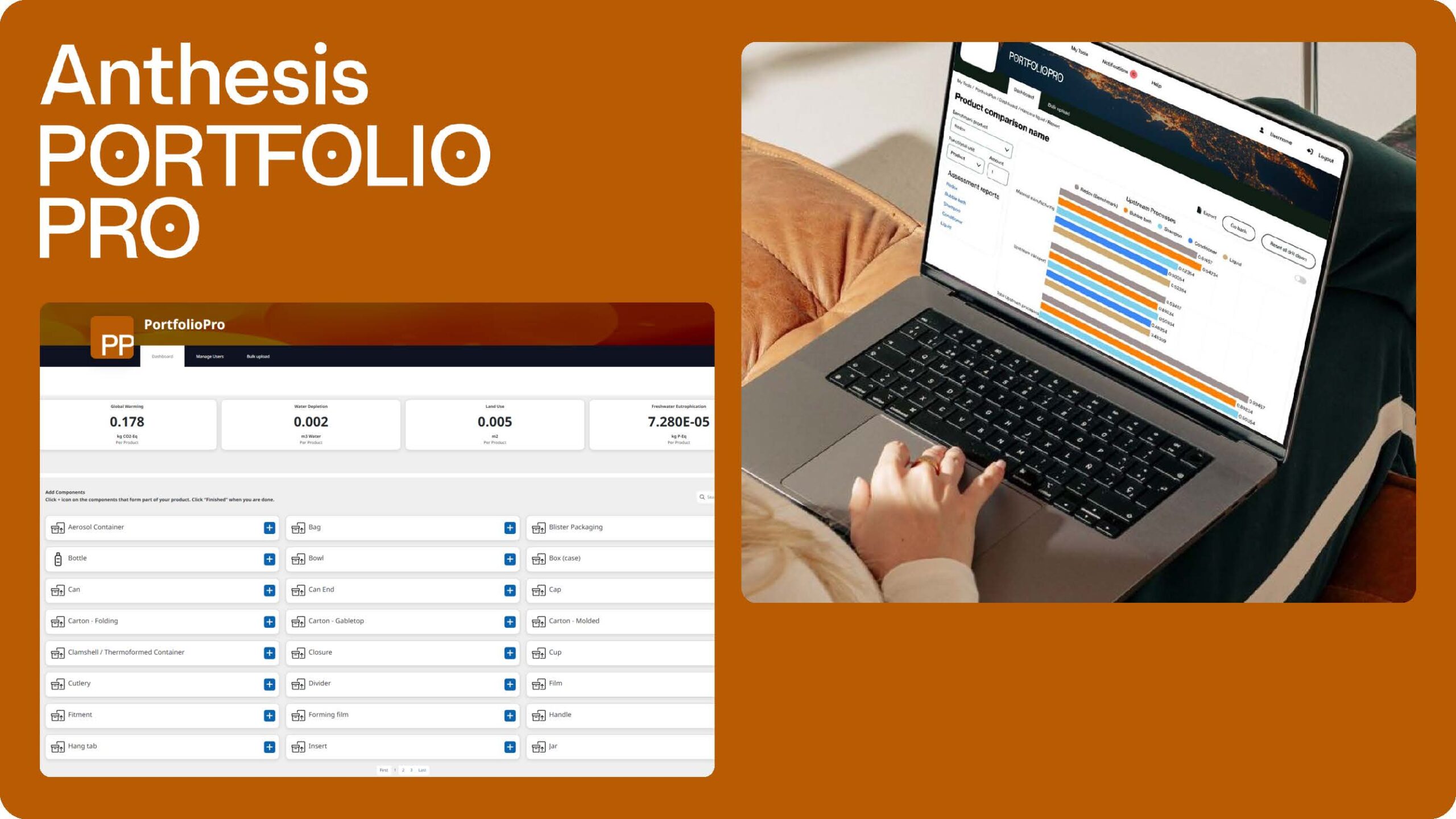
Table of Contents
- Benefits of Sustainable Design
- Regulations Driving Sustainability
- Leveraging Digital Tools
- Embedded Sustainable Design
- How Anthesis Can Help
- Contact Us
Share this article
Over the past six months, we’ve seen a significant shift in how companies approach sustainable product design. More businesses are moving beyond isolated eco-initiatives and are instead working to embed sustainability holistically across their product portfolios. The goal is clear: align with decarbonisation pathways, regulatory demands, and circularity principles, while also ensuring sustainable design is practical, scalable, and commercially viable.
This evolution marks a maturing of sustainable design efforts—companies are no longer just looking at individual products but at system-wide solutions that integrate sustainability into decision-making, supply chains, and product strategies. It’s a shift driven by a mix of regulatory pressure, financial incentives, and an increasing recognition that sustainability is now a core business function, not an add-on.
Why Sustainable Design Makes Business Sense
Sustainable product design isn’t just about reducing impact—it’s about building resilient, future-ready businesses. Companies that integrate sustainability into their design processes see benefits that go beyond compliance, from stronger market positioning to long-term cost savings.
Sustainability as a Competitive Advantage
Sustainability is no longer an optional add-on—it’s a defining factor in market leadership. Consumers are increasingly aware of the environmental impact of their purchases, and in our work with global brands, we see that companies making genuine, measurable commitments to sustainability are building stronger customer loyalty. Businesses that fail to align with these expectations risk losing market share, as sustainability-conscious consumers actively seek out alternatives.
The investment landscape is shifting too. Over the past year, we’ve seen investors implement more rigorous ESG assessment processes, requiring companies to demonstrate how sustainability risks are managed at both the corporate and product levels. The introduction of mandatory reporting frameworks like the Corporate Sustainability Reporting Directive (CSRD) will accelerate this trend, making it easier for investors to distinguish between companies that take sustainability seriously and those that don’t.
For businesses, this means that sustainable product design isn’t just about regulatory compliance—it’s about staying relevant in an evolving marketplace. Companies that embed sustainability into product development from the start will have a clear advantage over those scrambling to retrofit solutions later.
Resilient Supply Chains Start with Sustainable Design
Product design decisions impact every stage of the supply chain, from raw material sourcing to production, logistics, and end-of-life recovery. As companies move toward circularity and responsible sourcing, many are facing short-term disruptions—switching suppliers, seeking alternative materials that are not yet available at scale, or adapting to regional supply constraints.
However, these challenges are part of a necessary transition. Companies that embed sustainability into their supply chains are ultimately building resilience in several key ways:
- Reduced dependency on volatile raw materials – Many traditional materials are subject to geopolitical risks, price fluctuations, and regulatory restrictions. By prioritising recyclable, bio-based, or locally sourced alternatives, companies can gain greater control over long-term supply stability.
- Diversified supplier networks – Businesses that proactively shift to more sustainable suppliers—even when it requires an initial adjustment—reduce the risk of future disruptions caused by compliance failures, resource shortages, or shifting regulations.
- Efficient production & material use – Designing for remanufacturing, modularity, and recyclability not only reduces waste and costs but also improves supply chain agility, as businesses are less reliant on virgin materials and single-source suppliers.
- Regulatory & market alignment – Many industries are seeing increased due diligence requirements (e.g., the EU Deforestation Regulation (EUDR), Supply Chain Due Diligence Act (CSDDD)). Companies that proactively integrate sustainability into supplier selection and procurement are better positioned to navigate these evolving compliance landscapes.
Sustainable product design is no longer just about lowering emissions—it’s about future-proofing operations. Businesses that invest in supply chain sustainability today will be the ones that can scale efficiently and adapt to future market pressures.
Operational Efficiencies & Cost Savings
Sustainable product design and circularity isn’t just about reducing environmental impact—it’s also a smart financial strategy. By making better materials choices, extending product lifespans, and designing for repairability, companies can lower operational costs, reduce waste, and improve customer satisfaction.
Many businesses underestimate the costs of product failures, high return rates, and warranty claims—all of which impact profitability. Investing in durability and modular design reduces these expenses while enhancing customer loyalty.
Selling replacement parts and repair kits is also emerging as a profitable, low-cost strategy that benefits both companies and customers. This approach aligns with right-to-repair regulations and strengthens brand perception and customer retention.
At the same time, optimising material use leads to cost savings across manufacturing and logistics. Companies that use fewer, better materials can simplify production, reduce waste, and improve supply chain efficiency.
By embedding sustainability into design from the outset, businesses avoid costly retrofits, stay ahead of compliance requirements, and build long-term financial resilience.
Sustainability is Now a Financial Imperative
Sustainability is no longer just a reputational issue—it’s a core financial consideration. With mandatory ESG reporting requirements such as the CSRD coming into effect, businesses must provide transparent, quantifiable evidence of how they manage sustainability risks.
Investors are no longer relying on self-reported commitments; they are actively assessing whether businesses have a structured, data-driven sustainability strategy. Companies that lack clear, measurable sustainability plans are increasingly seen as high-risk investments, facing capital access challenges, and shareholder scrutiny.
Conversely, businesses that embed sustainability are gaining preferential access to financing and investment opportunities. Many financial institutions are now offering sustainability-linked loans and green bonds, providing lower interest rates or better terms for companies that meet specific carbon reduction or circular economy goals.
Beyond investment, corporate buyers and major retailers are also raising supplier sustainability standards, integrating ESG criteria into procurement decisions. Companies that cannot demonstrate compliance with evolving environmental expectations risk losing business opportunities.
In this landscape, sustainable product design is an essential financial risk management strategy.
Regulations Driving Product Sustainability
The European Union is at the forefront of promoting a circular economy, implementing comprehensive regulations to ensure products are designed with sustainability in mind. Key among these are:
- Ecodesign for Sustainable Products Regulation (ESPR): Enforced since July 18, 2024, the ESPR sets ecodesign requirements for a wide range of products, aiming to make them more durable, repairable, and recyclable, thereby reducing their environmental footprint throughout their lifecycle.
- Packaging and Packaging Waste Regulation (PPWR): Adopted by the EU Parliament, the PPWR seeks to reduce packaging production and associated waste, improve recyclability, and grow the market for recycled content. It impacts all entities placing packaging on the EU market, both small and large.
- EU Battery Directive: The Battery Directive, coming into force in 2027, imposes stricter recyclability and information disclosure requirements on batteries used for electronic devices and electric vehicles.
These regulations, which may also apply to companies outside the EU that do business in Europe, underscore the EU’s commitment to a sustainable future, compelling businesses to integrate circularity principles into their product designs.
Digital Tools Are Now Critical for Compliance
As compliance and sustainability expectations grow, companies need reliable, scalable tools that integrate sustainability data into product development workflows. Regulations like ESPR, the Digital Product Passport (DPP), and the EU Battery Regulation are making Product Carbon Footprint (PCF) and Life Cycle Assessment (LCA) data a core requirement—not just for compliance, but for market access. At the same time, procurement teams and buyers are demanding greater transparency of product-level sustainability impacts before making purchasing decisions. This is particularly true in industries like electronics, automotive, and consumer goods. Traditional LCAs remain invaluable but can be slow and resource-intensive—creating a gap between sustainability ambitions and execution.
This is where smart digital tools are making an impact. For example, PortfolioPro, Anthesis’ digital LCA tool, is helping businesses:
- Equip product teams with instant datapoints of product environmental footprint to support sustainable design decisions.
- Create Scenarios of sustainable product design, enabling for direct and quick comparison on how changes in your design impact the overall environmental footprint of your product
- Generate compliance-ready data that can be used for reporting, acting as a central repository of the data as well.
- Assess product portfolios for impact hotspots and opportunities.

The businesses making real progress in sustainable design aren’t just tracking footprints—they’re actively integrating sustainability into decision-making across teams and departments.
The Shift from Ad-Hoc Sustainability Projects to Embedded Solutions
For years, many companies treated sustainable product design as a series of one-off initiatives—responding to specific regulations or market pressures rather than developing a unified approach. However, this fragmented strategy has often led to stalled progress and internal roadblocks.
Now, companies are recognising that sustainability must be an embedded, system-wide capability. Successful businesses are moving towards:
- Portfolio-Level Sustainability Strategies – Ensuring sustainability is embedded across product roadmaps rather than individual projects.
- Cross-Functional Collaboration – Integrating sustainability across R&D, procurement, compliance, and commercial teams.
- Implementation Support & Governance – Ensuring sustainability strategies aren’t just designed—but executed effectively.
Many of the businesses we work with have already taken steps towards sustainable product design and are now looking for the right structure, tools, and internal alignment to take it further. For example, we worked with Culligan International to develop a custom Design for Sustainability (DfS) program, helping them build a structured, scalable approach to sustainable product innovation. Through a bespoke toolkit, training, and internal engagement strategy, Culligan is now embedding DfS principles across its product portfolio, ensuring sustainability is a core driver of decision-making, rather than an afterthought.
How Anthesis Can Help
Sustainable product design is no longer about small improvements—it’s about transformation. Companies that build sustainability into their core business strategy will be the ones that thrive in a rapidly evolving market.
At Anthesis, we help businesses design, implement, and scale sustainability strategies that align with regulatory demands, commercial goals, and long-term resilience.
If your company is looking to go beyond ad-hoc sustainability efforts and create a truly embedded approach, we’d love to explore how we can support your journey.
Explore our Product Design Solutions
We create realistic product design solutions and R&D process transformation to help companies improve product sustainability and performance.
We are the world’s leading purpose driven, digitally enabled, science-based activator. And always welcome inquiries and partnerships to drive positive change together.





